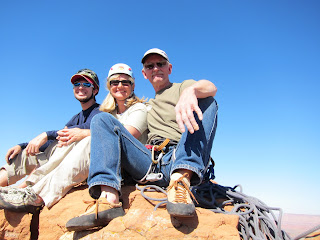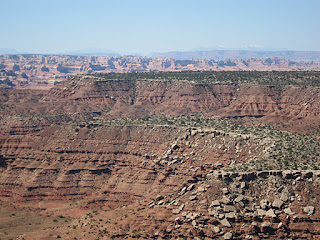There are two "Six Shooters" in Indian Creek, the North and the South. They dominate the horizon for 30 miles in every direction, making them an irresistible goal for a rock climber.
I was enjoying the morning eating a leisurely breakfast at the campground. A car drove by sporting an Alaska license plate. What?? I looked at the driver: it was my great friend Mark from Talkeetna. Amazing. "Mark I screamed and waved my arms; he didn't see me, but folks at the next campsite flagged him down. What a great coincidence. After a brief exchange, we decided to climb together the next day. Mark had planned to climb towers with his friend Stoney, now I was the third. I had just bought a 4-wheel drive truck, and the 4 1/2 mile hike in the powdery sand would be a slog, so I volunteered to drive us in the truck. A little cramped in a single cab, but with the big bench seat we all fit. It seemed to take as long to drive the road as we could have walked it. But, in the heat of the day, the truck was a welcome addition to our tool kit. We wound around the gullies, over some steep rocks, then down into a dry river bed following the tracks of other jeeps and trucks. The area is popular with the off-road vehicle crowd who had followed the old ranching roads up the wash to the base of the climb.
 Hiking up South Six Shooter
Hiking up South Six ShooterI had met Mark in 1996 when I and my friend Rick were in Mount Rainer National Park investigating the deaths of two park employees; Mark was our contact and guide on the mountain. We kept in touch over the years. Then Mark moved to Alaska, married Lisa who is the Base Camp Manager on Denali. Eventually he joined the Park Service as a ranger in Talkeetna. In 2010, Mark invited me to join his patrol on Denali; I couldn't resist. I wrote a little blog on the trip:
Mark, one of the finest alpinists in the country, has accumulated an impressive list of climbs, including The Escalator on Mt. Johnson in the Ruth Gorge, The East Face of Mount Grosvenor, the Denali Diamond route on Mt. McKinley's southwest face in less than 48 hours, and as I arrived in base camp he and Jesse Huey were climbing the Slovak Direct Route on Denali. He seems so humble about it all. I was delighted to be with him and Stoney today.
 Mark at the top of the first pitch
Mark at the top of the first pitchIt is still a hike up the trailless boulders and scree to the base of the actual climbing, but we made it in about 45 minutes; it took longer to drive the dirt road. At the base, another party was climbing ahead of us, so we took our time roping up. Stony flew up the 4th class cracks, Mark followed; I finished. Technically, the climb is unlike any other in Indian Creek. Very few long splitter cracks lead to the summit: mostly boulder hopping, a few hard moves and shaky boulders lead the way. I was having a blast with my two friends and hardly noticed the climbing. It was all about the friendship.
The summit was fantastic. We took in the views, made friends with two folks from Boulder, Colorado. Nice folks. Almost everyone I've met in the mountains has been special. It must take a certain kind of person to slog up a cliff.
Mark called Lisa from the summit. I was amazed that a cell phone could get reception through several mountain ranges to a cell tower 50 miles away, as the crow flies. It's a miracle.
 Mark finds a signal and calls Lisa from the summit.
Mark finds a signal and calls Lisa from the summit.After hanging out on the east, or higher summit, we rappelled down, climbed over and up the slightly more difficult west summit. Time to go. We set the ropes, rappelled down and took pictures of Ashley rappelling down the sheer face from the summit. Once down we took a nice lunch break at the start of the climbing where we had left our packs. As we hopped down the trail-like trace in the rock following cairns, Mark talked about his father, and I reminisced about mine.
*************************************INTERMISSION ************************************
That evening my friend Chris and her friend Noel arrived at the campsite after the long drive from Boulder. Chris and I had climbed here before, but this would be Noel's first experience on the splitter cracks. It's a brutal learning curve, so I thought that the South Six Shooter, which I had just climbed, would be a worthy goal for the day. I now knew the route, particularly the driving route in the truck! Back on the dusty road. I felt like a tour guide, but only after one trip to the rock. Bagging a desert tower the first day at 'The Creek' would be a great start to the trip.
*************************************INTERMISSION ************************************
That evening my friend Chris and her friend Noel arrived at the campsite after the long drive from Boulder. Chris and I had climbed here before, but this would be Noel's first experience on the splitter cracks. It's a brutal learning curve, so I thought that the South Six Shooter, which I had just climbed, would be a worthy goal for the day. I now knew the route, particularly the driving route in the truck! Back on the dusty road. I felt like a tour guide, but only after one trip to the rock. Bagging a desert tower the first day at 'The Creek' would be a great start to the trip.
 Noel and Chris
Noel and ChrisChris had quit her job in Denver and had spent the previous month supporting her niece on her Ph.D. dissertation field work on the San Juan river, just down the way from Indian Creek. She was in great shape and eager to climb. Noel, an excellent rock climber, was enthusiastic. We made an excellent team.
Back up the hour-long hike through the arroyos and boulders to the base of the climb. Since I was doing the leading, we have few photos of the climb, except for the fine summit shot!
 Noel, Chris, and I on the summit
Noel, Chris, and I on the summitDesert towers are fantastic places. The panoramas from the summit range from huge snow-capped mountains like the Abajos, the La Sals, and the Henry's, all visible from the Six Shooters. The La Sal mountains sit above Moab, Utah, and are my landmark from a hundred miles away as I drive I-70 south to Indian Creek each year. Twelve of the peaks in the range are over 12,000 feet high; Mount Peale, the highest peak rises to 12,721 feet. They, like the four other ranges in the viewshed are composed of igneous intrusions of porphyry.
 The view from the Top: The La Sal Mountains
The view from the Top: The La Sal MountainsThe Henry Mountains are the last mountain range in the U.S. to be mapped. John Wesley Powell mapped and named them during his field work floating the Colorado river in 1872, doing so in honour of Joseph Henry, the first secretary of the Smithsonian Institution. The Henry Mountains are composed of igneous rocks, a 25 million year old intrusion into the Colorado Plateau. They are the home of about 500 bison; the herd is one of only four free-roaming and genetically-pure herds in North America.
The Henry Mountains in the distance
The rappel from the top is spectacular! A vertical to overhanging wall about 100' high rises directly from the base. I enjoyed photographing Chris and Noel as they roped down the rock.
The rappel from the top is spectacular! A vertical to overhanging wall about 100' high rises directly from the base. I enjoyed photographing Chris and Noel as they roped down the rock.
In the evening, we walked over to the big campfire at the end of the campground. All the Silverbacks were holding court in their camp chairs. The stories grew, the legends increased, the we were part of it all.



















































